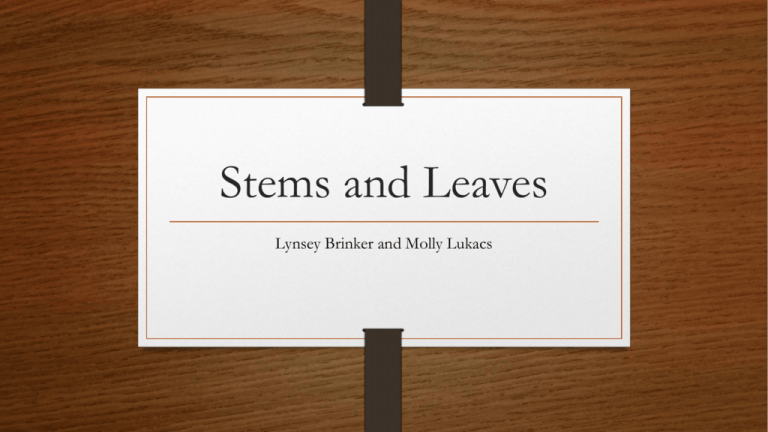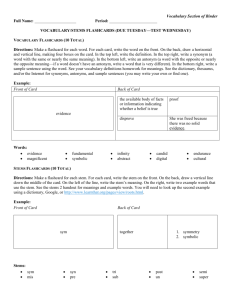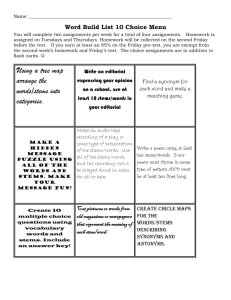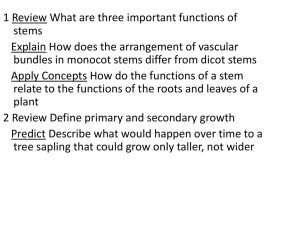Stems and Leaves
advertisement

Stems and Leaves Lynsey Brinker and Molly Lukacs Stems • Purpose of stems • Support leaves • Store water and food • Transport water and nutrients • Growth in height only happens at roots and branches Stems • Special stems: Cactus • Majority of cactus is a stem • Stores food and water for plant • The spines are actually leaves • Special stems: Rhizomes • Underground stem NOT A ROOT Stems • Special Stems: Corms • Short underground stem • Special Stems: Stolons • Slender above ground stem • Ex. Strawberry shoots • Special stems: Bulbs • Food storage ex. Onions and tulips Stems • Where do stems grow • Apical meristems • Growth occurs at tip of stem; top of the plant • Lateral meristems • Growth in diameter Stems (structure) • Nodes • Location where new leaves are formed • Internode • Area or space between two segments or in a joint • Lenticels • Pores in surface of the stem to allow gas exchange Stems (structure) • Buds • Terminal • Located at the end of a stem • Lateral • Located on side of stem • Bud scales • Protective covering around buds (embryonic shoots) Stems (primary growth) • Epidermis • Outer layer of protection • Cortex • Next layer inside epidermis • Food storage Stems (primary growth) • Pith • Center of stem; food storage • Vascular Bundles • Xylem • Transfers H2O • Phloem • Transfers food Stems (types) • Monocot • Vascular bundles are scattered • Xylem in center Phloem on outside • Dicot • Vascular bundles make a circle • Xylem closer to center • Phloem behind xylem Stems (secondary growth) • Occurs mostly in dicots because monocots lack lateral meristems • Stems increase in diameter due to the lateral meristems • Two types • Vascular cambium • Cork cambium Stems (secondary growth) • Vascular Cambium • Produces new xylem, phloem through cell division • This becomes a secondary xylem and phloem • Wood • Secondary xylem • Heartwood (pith) • Primary xylem; stopped transporting H2O Stems (secondary growth) • Sapwood • New secondary xylem • Lighter colored • Bark • Provides protection for woody stems • Made up of cork. cork cambium, phloem Stems • Why is bark rough or cracked • Cells aren’t living • Cork cambium produces cork and dies before maturity • As the tree grows cork ruptures and cracks Stems How old is my tree? • Annual rings show the growth of the tree per season • They can be used to tell the approx. age of tree • Thick rings = moist good growing conditions • Think rings = drought or poor growing season Leaves (function) • Primary site of photosynthesis • Site of transpiration • Site of gas exchange • Leaf structures • Important for plant id • Blade: broad, flat portion: site of photosynthesis • Petiole: stalk like region where it attaches to stem Leaves (three tissue layers) • First • Epidermis layer: usually one cell layer thick • On top and bottom of leaf • Impermeable cuticle (top and bottom) • H2O, O2, and CO2 enter and exit through stomata (bottom only) Leaves (three tissue layers) • Second • Mesophyll layer – organized into two layers • Palisade Mesophyll • Lays directly beneath upper epidermis • Tightly packed into one or two cell layers • Spongy Mesophyll • Beneath palisade layer • Balloon shaped cells Leaves (three tissue layers) • Vascular layer • Consists of vascular bundles called veins (circular) • Continuous with vascular bundles in stem and petiole • Veins branch repeatedly so each cell in less than 1mm from a vein Leaves (venation) Arrangement of veins in a leaf • Monocots vs Dicots • Monocots • Parallel venation ex. Grasses • Dicots • Net venation ex. maple Leaves (processes) • Transpiration • Evaporation of water in plants through stomata • Gas Exchange • Exchange of CO2 and O2 through stomata • Stomata: bordered by 2 kidney shaped guard cells • Modified epidermis cells that regulate H2O and gas exchange • Open during day closed during night: contained chloroplasts Leaves (processes) • Photosynthesis • Process when chlorophyll and enzymes in leaves convert certain wave lengths of light to chem. energy • Equation Sunlight + CO2 + H2O > Carbohydrates + O2 Leaves (photosynthesis) • Chloroplasts: Sacks that contain photosynthetic pigments • Site of photosynthesis • Thylakoids: Series of flattened sacks • Acts like solar panels to collect sun energy • Grana: Stacks of thylakoids • Stroma: Liquid solution which contains 4 pigments • Surrounds grana Leaves (photosynthesis) • Chlorophyll • Chlorophyll A = 95% • Chlorophyll B = 5% • 2 other pigments • Xanthophylls – yellows • Carotenes – oranges Leaves (photosynthesis) • Spring/Summer • Only green is reflected = seen • All other colors hidden • Fall colors • Chlorophyll is all used up, see all other reflected pigments • Chromatography • Technique used to separate a mixture into its different components Leaves (plant id) • • • • • 1. Arrangement of leaves on stems 2. Divisions in a leaf 3. Shape 4. Character of leaf margin 5. Veins Interactive Links • Leaf Game • www.wartgames.com/themes/plants/leaves.html • Why Leaves Change Colors • http://www.education.com/activity/article/leaves_change_fifth/ • All About Leaves • www.mrsjonesroom.com/themes/trees.html • Stems, Leaves, and Transpiration • http://www2.yk.psu.edu/~sg3/ist311/games/team3/phasethree.html • Stem Activity • http://studyjams.scholastic.com/studyjams/jams/science/plants/roots-stems.htm Videos • Plant nutrition and transport • https://www.youtube.com/watch?v=bsY8j8f54I0 • Parts of a plant – stems • https://www.youtube.com/watch?v=VuMxN1j9f6Y • The parts of a plant and its function • https://www.youtube.com/watch?v=CPAIr1sY9RU • Why leaves change color • https://www.youtube.com/watch?v=cyj7kyYX_gQ • Leaf color chromatography • https://www.youtube.com/watch?v=qH-AJDqsSII Work Cited • Dictionary.com. Dictionary.com, n.d. Web. 08 Jan. 2015. • "Leaves and Leaf Anatomy - EnchantedLearning.com." Leaves and Leaf Anatomy - EnchantedLearning.com. N.p., n.d. Web. 06 Jan. 2015. • "Plant Biology: Roots, Shoots, Stems, and Leaves." - For Dummies. N.p., n.d. Web. 08 Jan. 2015. • "Plant Stem." Wikipedia. Wikimedia Foundation, n.d. Web. 08 Jan. 2015. Work Cited • "Plant Structure and Function." Plant Structure and Function. N.p., n.d. Web. 05 Jan. 2015. • "Plant Structures: Cells, Tissues, and Structures." Plant Structures: Cells, Tissues and Structures. N.p., n.d. Web. 06 Jan. 2015. • "Plant Structures: Leaves." Plant Structures: Leaves. N.p., n.d. Web. 06 Jan. 2015. • Richards. "Plants: Roots, Stems, and Leaves." Plants: Roots, Stems and Leaves (n.d.): n. pag. Web. 06 Jan. 2015.






